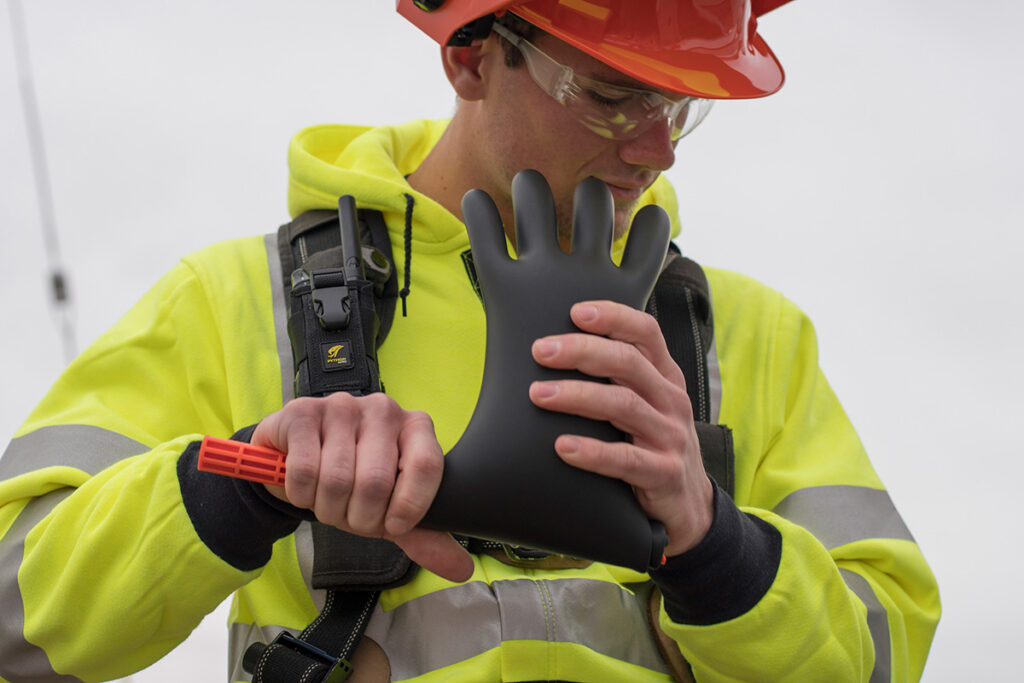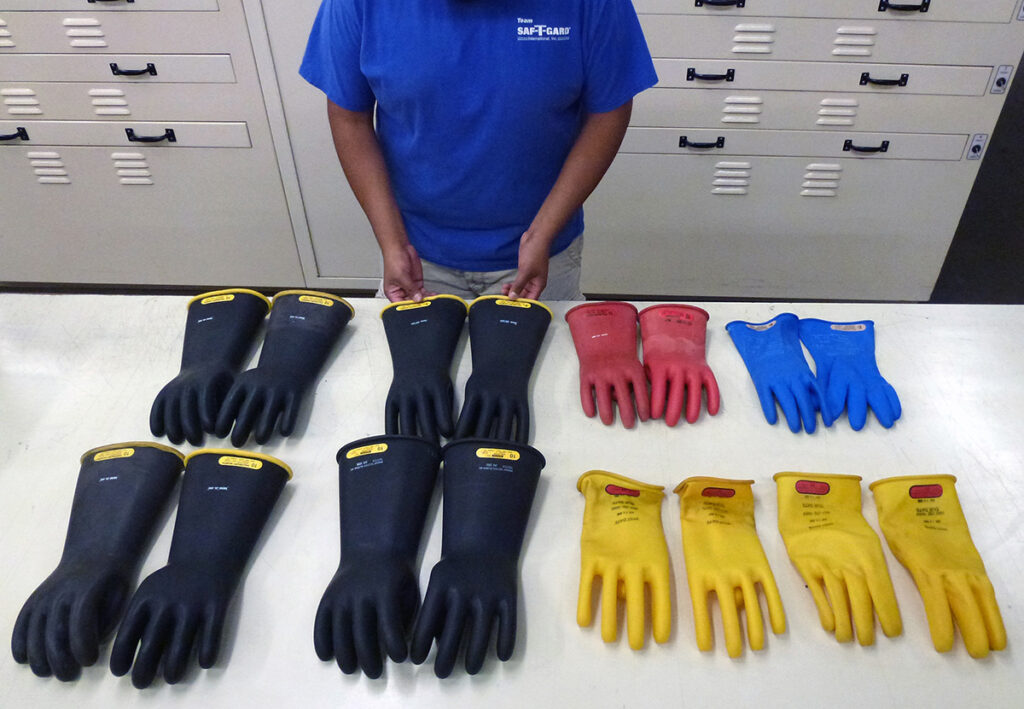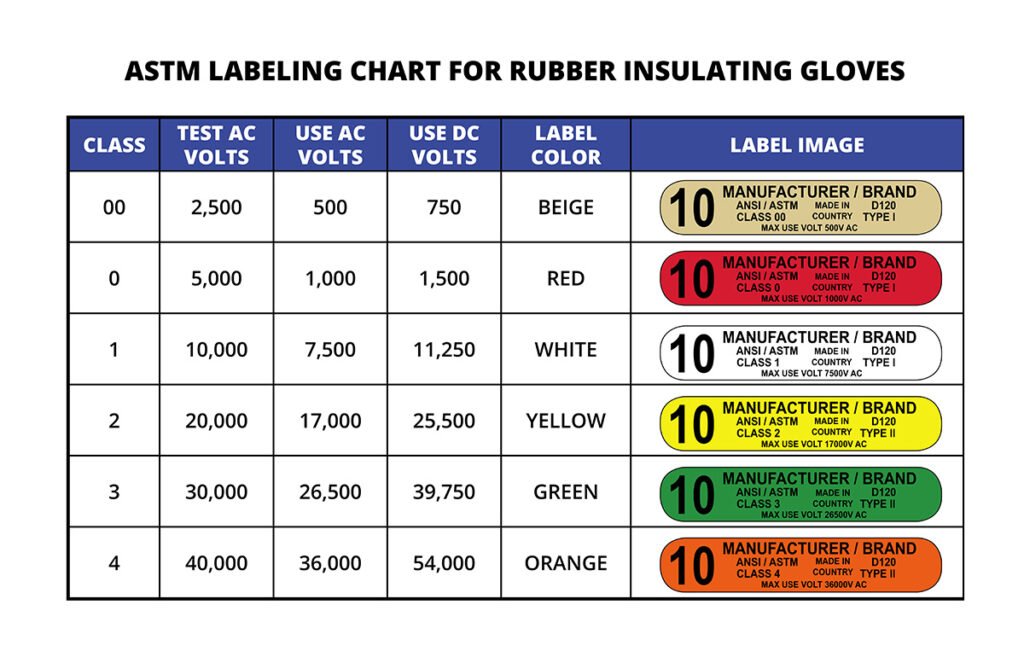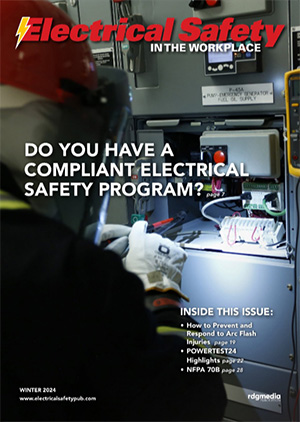Electrical Gloves: Best Practices for Building an Electrical Safety Program

All electrical gloves should be thoroughly inspected prior to use. Image courtesy of Saf-T-Gard International, Inc.
How to protect the gloves that protect you.
By Richard Rivkin, Contributor
Contact with or exposure to electricity continues to be one of the leading causes of workplace fatalities and injuries in the United States. Between 2011 and 2021, there were 1,201 workplace fatalities involving electricity reported by the Occupational Safety and Health Administration (OSHA) and 1,653 electrical fatalities reported by the Bureau of Labor Statistics. Markedly, only 31% of these fatalities were in electrical occupations, which greatly underscores the need for awareness of and protection from electrical hazards across all industries.
It is important to note that there have been great strides made in that exposure to electricity is no longer a stand-alone leading cause of workplace fatalities. It is now included in a group of “exposures to harmful substances or environments” of which exposure to electricity accounted for 145 deaths in 2022 compared to 600 electrocutions annually in the 1970s — a vast improvement since NFPA 70E began addressing electrical safety. Nonetheless, workers in a wide variety of occupations and work settings may be exposed to electrical hazards that place them at risk of serious injury or death.
Because sources of electrical energy are so commonplace, they may oftentimes be taken for granted, leaving employees vulnerable to dangers they don’t recognize. Although progress has been made in reducing work-related electrical fatalities, more can be done to improve the recognition of electrical hazards and improve safe work practices. Whether you are working on power lines or in an industrial facility, mitigating the risks requires a multi-pronged approach to electrical safety.
GLOVE UP!
Rubber insulating gloves (electrical gloves) are the only protective gear designed for constant contact with, and protection from, energized conductors and equipment. All the other items are designed for protection from accidental, incidental or brush contact.
Arc-rated work gloves alone provide no protection from voltage. Electrical gloves are an essential element in protecting workers that are exposed to high-voltage currents. Shock protection is the primary benefit. However, electrical gloves worn together with the appropriate leather protector gloves also provide significant burn protection in the event of an arc flash.
According to the OSHA 29 CFR 1910.137 standard, electrical gloves must be rated for the voltage to which a worker will be exposed (phase to ground or phase to phase) and marked to indicate their rating. For in-service use, the maximum use voltage must be above the actual exposure, but it is important to take note of the proof-test voltage as well. Electrical gloves are offered in six different voltage rating “classes”, based on ASTM D120, and each class of gloves is clearly marked with the maximum-use voltage on the permanent color-coded label. All electrical gloves are tested by the manufacturer at the specified proof-test voltage.
Source: Saf-T-Gard International, Inc.
Manufacturers also perform a dielectric breakdown test at an even higher voltage to validate the dielectric strength of the rubber material. The result is a significant margin of safety between the proof-test voltages and the maximum-use voltage. Each specific hazard assessment will help you determine which class of electrical gloves is appropriate for your application.
INSPECTION HELPS ENSURE PROTECTION
ASTM F496 In-Service standards require the regular inspection of in-service electrical gloves. All electrical gloves should be thoroughly inspected prior to use. Common problems to look for include the following:
- Cracking and Cutting – Prolonged folding or compressing can cause this type of rubber damage.
- UV Checking – Storing in areas exposed to prolonged sunlight causes UV checking.
- Chemical Attack – Oils and petroleum compounds can cause swelling of the rubber.
- Avoid Folding – The strain on rubber at a folded point is equal to stretching the rubber to twice its length.
- Snags – Wood, metal splinters and other sharp objects can snag or tear rubber.
- Physical Damage – Rope burns, deep cuts and puncture hazards are causes for rejection.
Visually inspecting electrical gloves identifies physical, chemical or ozone damage. Direct light is recommended because it enhances the ability to see surface imperfections on the rubber. Inflating the gloves with air or otherwise stretching the surface helps identify age and ozone damage as well as other physical damage such as snags, rope burns, deep cuts and punctures. A portable, mechanical inflator may be used in the field to enhance the inspection of the glove and identification of any damage. Simply affix the glove to the inflator and pump it up to view any damage to the glove that is not otherwise visible unless viewed after inflating.

According to the OSHA 29 CFR 1910.137 standard, electrical gloves must be rated for the voltage to which a worker will be exposed (phase to ground or phase to phase) and marked to indicate their rating. Image courtesy of Saf-T-Gard International, Inc.
PROTECTING THE GLOVES THAT PROTECT YOU
With few specific exceptions, electrical gloves must always be worn with protector gloves manufactured in compliance with ASTM standard specification F696 (leather protector gloves) or F3258 (protectors meeting specific performance requirements). The OSHA “269” standard (29 CFR 1910.269) requires that rubber insulating gloves along with protector gloves must be worn by qualified employees within the Minimum Approach Distance (MAD) to exposed energized conductors. As such, equal care and consideration should also be given when selecting the appropriate protector gloves.
Protector gloves are worn over electrical gloves to extend their life and provide protection to the rubber gloves from physical hazards. Keep in mind that there is a tracking and flashover risk which increases as the voltage potential increases. Since the materials in the protector gloves have no dielectric properties and may absorb moisture or at least track electricity, it is important to maintain a gap between the protector glove and the wearer’s body parts, i.e. hand and arm.
Therefore, the protector must be shorter than the electrical glove so that there is exposed rubber as a line of defense against tracking and flashover. The applicable ASTM specifications state that the minimum distance between the edge of the protector and the cuff edge of the electrical glove is ½ inch for low-voltage gloves and 1 inch per glove class for high-voltage gloves. Knowing this, the protector for a Class 2 electrical glove must be at least 2 inches shorter than the electrical glove.
TEST TO ENSURE SUCCESS

Inflating gloves with air or stretching the surface helps identify age and ozone damage as well as other physical damage such as snags, rope burns, deep cuts and punctures. Image courtesy of Saf-T-Gard International, Inc.
Damage to many types of personal protective equipment (PPE) can be apparent when the equipment or devices are inspected by the user. However, electrical gloves are more complicated. It is important to note that the reduction in effectiveness can be caused by a variety of factors that may not be readily apparent to the user, and improper use of electrical gloves can be a matter of life and death. The best way to ensure that electrical gloves are safe for their intended use is to have them periodically re-tested at their proof-test voltage by a qualified test lab.
ASTM standards mandate the testing of electrical gloves by the manufacturer or supplier prior to the first delivery to the end user. Users also have the option of performing or requiring an acceptance test upon receipt of the goods and prior to placing electrical gloves into service.
The interval between the date of issue and electrical testing should be based on work practices and test experience. For electrical gloves, the interval shall not exceed six (6) months except for industries such as telecommunications that utilize insulating gloves as precautionary protection, in which case the maximum interval may be increased to nine (9) months. However, do not place electrical gloves into service unless they have been tested electrically within the previous twelve (12) months. These in-service re-test intervals are the MAXIMUM permitted and in addition to the daily field care and inspection. It is quite common for users, including power utilities and contractors, to specify shorter intervals.
Periodic re-testing of electrical gloves should be performed at the proof-test voltage to ensure that they are still safe using specialized equipment designed to gradually increase the voltage to the desired test level. The dielectric test is two-fold: pass/fail on the ability to withstand the rated test voltage and, for gloves, quantitative on the ability to prevent electric current from passing through the electrical gloves above the maximum contained in the specifications.
Products passing the inspection and test procedures can then be returned to service for continued use and cost savings over purchasing a new pair of electrical gloves that could have been re-tested and re-certified by a qualified test lab for a fraction of the cost. If you do not have the equipment required to perform these electrical tests, there are independent testing facilities that can perform the acceptance and in-service testing on behalf of end users. At a minimum, ASTM standards require that the inspection and testing process include the following steps:
- Check-in
- Removing previous testing marking
- Washing using cleaning agents that will not degrade the insulating properties
- Visual inspection of all surfaces (inside and out)
- Electrical test
- Final inspection
- Recordkeeping
- Marking
- Packing in appropriate containers (“appropriate containers” means boxes, or similar sturdy packaging materials to prevent folding, creasing or similar loose storage that can cause stress on the rubber) for storage or shipment
When selecting a test lab for use, make sure that it is a NAIL-accredited test lab. NAIL stands for National Association of Independent Laboratories for Protective Equipment Testing (www.nail4pet.org). It incorporates the only Laboratory Accreditation for the electrical equipment test labs program in North America. NAIL4PET helps develop uniformity in testing and works in close association with the American Society of Testing Materials (ASTM International).
TEST IT AS YOU USE IT
Electrical testing is not just reserved for alternating current (AC) voltages. For maximum safety, it is important to understand the application for use and test the electrical gloves as close as possible to that environment. While AC testing is applicable for general use, DC (direct current) testing is necessary for electrical gloves in applications where there is exposure to DC, including (but not limited to) electric vehicles (EV), both fully electric and plug-in hybrid, renewable power generation (wind and solar particularly), and electrified mass transit and transportation.
Moreover, the ASTM Specifications for Electrical Protective Equipment for Workers do include both AC and DC test voltages and maximum use voltages for safety. Therefore, it makes sense to DC test electrical gloves where there is exposure to DC energized circuits and equipment.
CONCLUSION
Fortunately, there are procedures that you can implement to avoid the lost time, damage to equipment and facilities, legal liability, increased insurance premiums, hefty fines and unnecessary PPE spending that can result from arc flash and electrical incidents. While the best way to prevent arc or electrical incidents from happening is through engineering controls such as de-energizing equipment before beginning work, there are instances when turning off the power could create an even greater hazard. Therefore, employers and facility owners must establish safe practices to protect their workers against arc flash incidents including the use of PPE.
The National Fire Protection Association (NFPA) along with the Occupational Safety and Health Administration (OSHA) mandates and enforces safer electrical work practices under the NFPA 70E standard. Numerous experts and training programs are available to provide guidance on how to keep workers safe and compliant in terms of conducting a proper arc flash hazard analysis.
The results of the analysis will usually guide the property owner regarding the controls that should be in place (engineering, mechanical, human or otherwise) and review the hazards of both arc flash and electrical shock. From there, proper PPE options – such as electrical gloves – can be determined.
Nearly every industrial workplace has a need for electrical gloves, and regulatory standards require ongoing inspection and testing of in-service equipment in order to maintain compliance and ensure the products’ integrity and safety when exposed to a wide range of voltages. Knowing how to select the right electrical glove (and leather protector) for the application and implementing a care and maintenance plan that includes the inspection and periodic re-testing of electrical gloves is crucial for the continued confirmation of effectiveness and the overall success of your electrical safety program. ESW
Richard A. Rivkin is CEO and Chairman of the Board at Saf-T-Gard International, Inc., a privately-held family-owned and -operated global supplier of industrial safety products based in Northbrook, Illinois. Founded in 1936 as Latex Glove Company, Saf-T-Gard carries on the tradition that was started more than 85 years ago: bringing customers the products, training and service they need to keep employees safe in the workplace. Saf‑T‑Gard actively operates the Voltgard® Test Lab, one of the largest, independent, NAIL4PET-accredited test labs for rubber insulating products in the United States. To learn more, please visit www.saftgard.com or call 1-800-548-GARD (4273).
Share on Socials!
Watch Out for These Electrical Hazards in Your Construction Site
Electrical Safety Statistics: Why Are Workers Still Dying on the Job
Understanding the Cybersecurity Standards Enabling Trusted IIoT Connections
Leaders in Electrical Safety
• Aramark
• Bowtie Engineering
• Enespro
• Ericson
• I-Gard Corporation
• IRISS
• KERMEL, INC.
• Lakeland Industries
• MELTRIC Corporation
• National Safety Apparel
• National Technology Transfer
• Oberon
• Saf-T-Gard
• SEAM Group
Subscribe!
Sign up to receive our industry publications for FREE!








